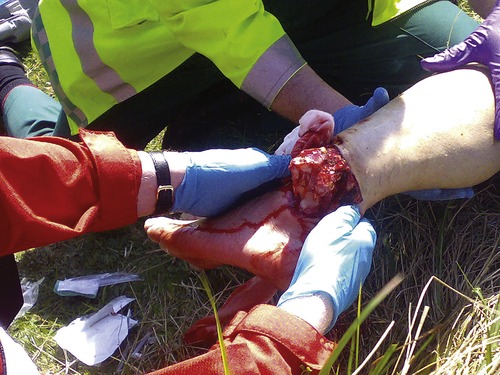CASE 18
 |
Incident
A cyclist has been hit by a car and has sustained an isolated open fracture dislocation of the ankle.
Clinical information:
• P 110.
• BP 150/90 mmHg.
• RR 22.
The foot is dusky and pulseless and the patient is screaming in pain.
Relevant information
▪ Aircraft: Rotary wing
▪ Ground resources: One land ambulance
▪ Retrieval options: Major trauma hospital 1 hour by air. General hospital 15 minutes by air
▪ Other: Ambient temperature 35°C (95°F)
Questions
Discussion
18.1 Scene safety issues should be addressed as discussed earlier. The weather is hot and transport times are potentially lengthy so think additionally of fatigue and dehydration in yourself, your team and the patient. The patient will need fracture manipulation and analgesia is an urgent requirement.
Triage decisions may seem straightforward (i.e. the nearest hospital has an orthopaedic surgeon) but consider potential requirements for vascular repair and/or advanced plastic surgical involvement when significant tissue loss is present.
18.2 This question concerns adequate analgesia but also safe sedation in the pre-hospital environment.
Pain management
Psychological
• Reassurance.
• General patient comfort (ambient temperature protection).
• Explanation – what you are about to do and what to expect.
• Distraction – especially for children but works for adults too.
Non-pharmacological
• Anatomical realignment.
• Splinting techniques.
• Minimising patient movements and handling where possible.
• Dressings of open wounds.
Pharmacological
• Oral.
• Inhaled.
• Intravenous.
• Regional.
In this instance, it is clear that the patient needs emergency limb alignment and plans should be made for this to occur immediately. In the interim, inhaled analgesic agents (if locally available) and oxygen can be administered to the patient.
Preparation for sedation
The patient
• Explain your plan and obtain verbal consent. Make sure that there is no co-existing injury by completing the primary survey. Gain large-bore intravenous access and ensure the patient is in a safe location with 360 degree access and is adequately positioned.
< div class='tao-gold-member'>
Only gold members can continue reading. Log In or Register to continue
Stay updated, free articles. Join our Telegram channel

Full access? Get Clinical Tree








